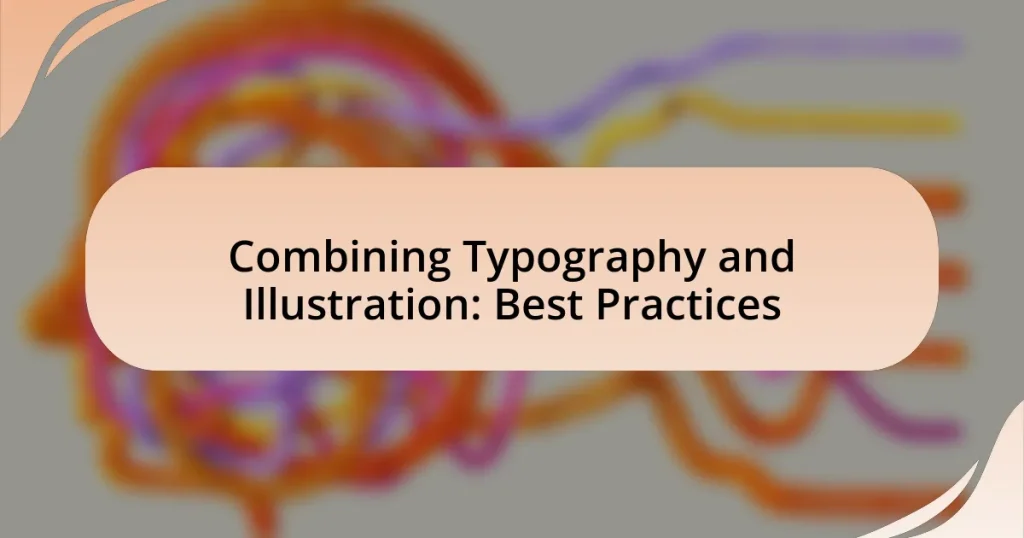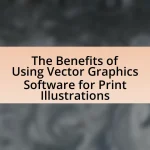The article focuses on the integration of typography and illustration, emphasizing best practices for creating cohesive designs that enhance visual communication. It outlines how typography and illustration complement each other, detailing key elements of both, such as typeface, clarity, and color theory. The article also discusses the importance of this combination in improving user engagement and information retention, while providing practical tips for achieving balance and harmony in design. Additionally, it highlights tools and resources available for effective integration, along with examples of successful applications in various projects.
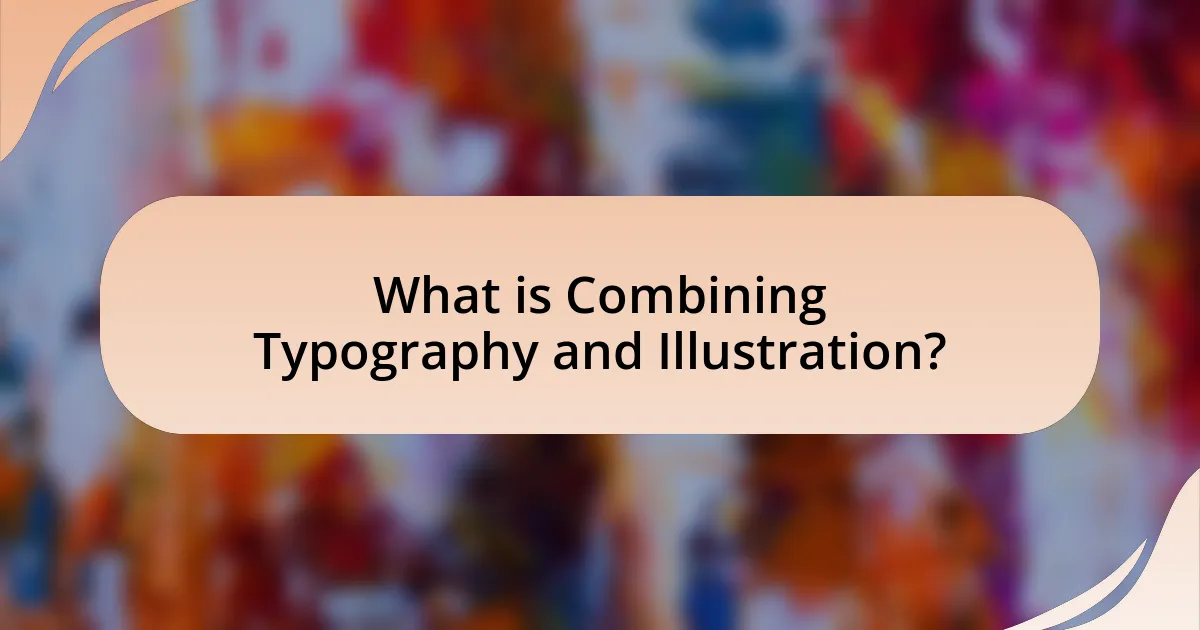
What is Combining Typography and Illustration?
Combining typography and illustration refers to the integration of text and visual imagery to create a cohesive design that enhances communication. This practice leverages the strengths of both elements, where typography conveys information and emotion through font choice and layout, while illustration adds visual interest and context. Research indicates that designs incorporating both typography and illustration can improve viewer engagement and retention of information, as seen in studies on visual communication effectiveness.
How do typography and illustration complement each other?
Typography and illustration complement each other by enhancing visual communication and creating a cohesive design narrative. Typography provides structure and readability, while illustration adds emotional depth and visual interest. For instance, a well-chosen typeface can set the tone of a message, while an illustration can evoke feelings that resonate with the audience, making the overall design more engaging. Research shows that designs combining both elements can improve user retention and comprehension, as seen in studies by the Nielsen Norman Group, which highlight the effectiveness of visual aids in information processing.
What are the key elements of typography?
The key elements of typography include typeface, size, line length, line spacing, letter spacing, and alignment. Typeface refers to the design of the letters, which can convey different moods and messages; for example, serif fonts often appear more traditional, while sans-serif fonts are seen as modern. Size determines the readability and impact of the text, with larger sizes typically used for headings and smaller sizes for body text. Line length affects how easily text can be read; optimal line length is generally between 50 to 75 characters. Line spacing, or leading, influences the visual comfort of the text, with increased spacing enhancing readability. Letter spacing, or tracking, can affect the overall appearance and legibility of the text, while alignment (left, right, center, or justified) impacts the text’s organization and flow. These elements work together to create effective and visually appealing typography in design.
What are the fundamental aspects of illustration?
The fundamental aspects of illustration include clarity, composition, color theory, and style. Clarity ensures that the illustration effectively communicates the intended message, while composition involves the arrangement of elements to create a visually appealing and balanced image. Color theory plays a crucial role in evoking emotions and setting the tone, and style refers to the unique artistic approach that defines the illustration. These aspects are essential for creating impactful illustrations that resonate with the audience and enhance the overall design.
Why is the combination of typography and illustration important?
The combination of typography and illustration is important because it enhances visual communication and engages the audience more effectively. Typography provides the textual information while illustrations add visual context, making the content more memorable and appealing. Research indicates that visuals can increase information retention by up to 65%, demonstrating that the integration of these elements can significantly improve comprehension and engagement. This synergy allows for a cohesive design that captures attention and conveys messages more powerfully than text or images alone.
How does this combination enhance visual communication?
The combination of typography and illustration enhances visual communication by creating a cohesive and engaging narrative that captures attention and conveys messages effectively. Typography provides structure and hierarchy, guiding the viewer’s eye, while illustrations add emotional depth and context, making the content more relatable. Research indicates that visuals can increase information retention by up to 65%, demonstrating that this combination not only attracts attention but also aids in comprehension and memory.
What impact does it have on user engagement?
Combining typography and illustration significantly enhances user engagement by creating visually appealing and easily digestible content. Research indicates that well-designed typography can improve readability and comprehension, while illustrations can capture attention and evoke emotions, leading to a more immersive user experience. For instance, a study by the Nielsen Norman Group found that users are 80% more likely to read content when it is accompanied by relevant images. This synergy between typography and illustration not only attracts users but also encourages them to interact with the content, ultimately increasing time spent on the page and the likelihood of sharing.
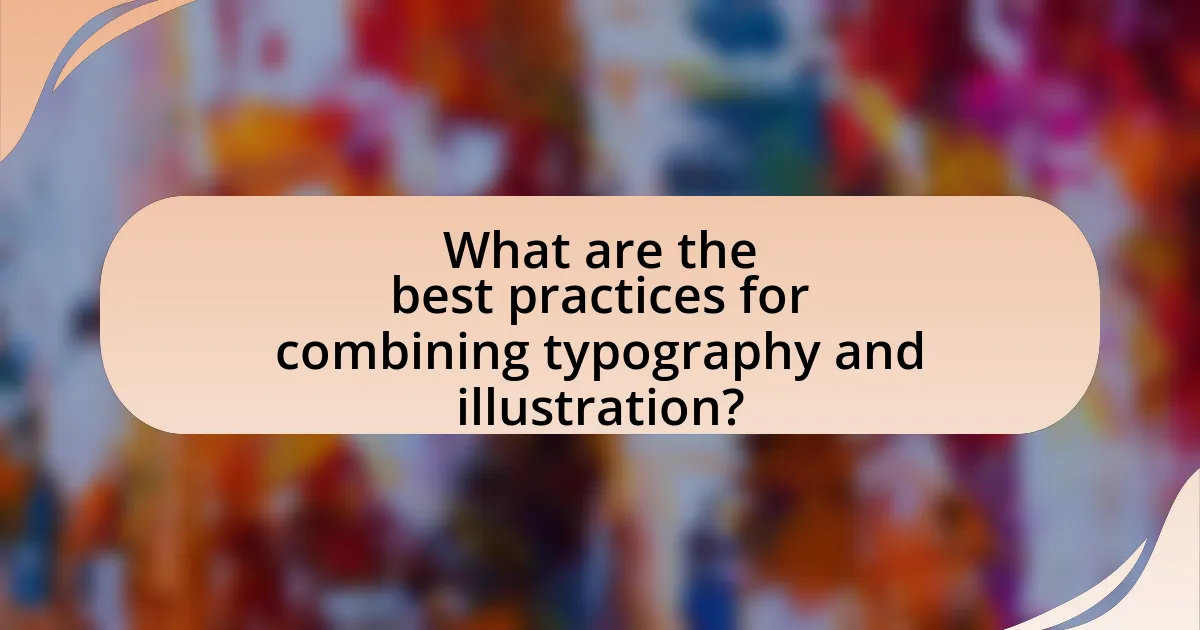
What are the best practices for combining typography and illustration?
The best practices for combining typography and illustration include ensuring harmony between the two elements, maintaining readability, and using contrast effectively. Harmony can be achieved by selecting typefaces that complement the style of the illustration, creating a cohesive visual narrative. Readability is crucial; the text should be legible against the illustrated background, which may involve adjusting font size, weight, and color. Effective contrast enhances visibility and draws attention to key messages, often achieved by using light text on dark backgrounds or vice versa. These practices are supported by design principles that emphasize the importance of visual balance and clarity in communication.
How can one achieve balance between typography and illustration?
To achieve balance between typography and illustration, one should ensure that both elements complement each other without overpowering. This can be accomplished by selecting a typeface that harmonizes with the style of the illustration, maintaining a consistent color palette, and using appropriate spacing to create visual harmony. Research indicates that effective design relies on the principle of contrast, where typography and illustration should differ enough to be distinct yet similar enough to feel cohesive. For instance, a bold typeface can be paired with a detailed illustration to create a dynamic visual impact, while a more delicate typeface may work better with simpler illustrations.
What techniques can be used to create harmony?
Techniques to create harmony in combining typography and illustration include using a consistent color palette, maintaining a cohesive style, and ensuring proper alignment. A consistent color palette unifies the elements, making them visually appealing and connected; for example, using complementary colors can enhance readability and aesthetic appeal. Maintaining a cohesive style, such as matching the illustration style with the typography (e.g., both being modern or vintage), ensures that the elements feel like part of a single design. Proper alignment of text and illustrations creates a balanced layout, which is crucial for guiding the viewer’s eye and enhancing overall comprehension. These techniques are supported by design principles that emphasize visual coherence and clarity in communication.
How does scale affect the relationship between typography and illustration?
Scale significantly influences the relationship between typography and illustration by determining their visual hierarchy and interaction. When typography is scaled larger, it often commands more attention, potentially overshadowing illustrations, while smaller typography can integrate more harmoniously with illustrations, allowing both elements to coexist without competition. For instance, in design layouts, a larger typeface can create a focal point that directs the viewer’s gaze, while smaller text can serve as supplementary information that complements the visual narrative of the illustration. This dynamic is crucial in effective design, as it ensures that both typography and illustration work together cohesively to convey the intended message.
What role does color play in this combination?
Color plays a crucial role in the combination of typography and illustration by enhancing visual hierarchy and emotional impact. In design, color can guide the viewer’s attention, differentiate elements, and convey specific moods or themes. For instance, warm colors like red and orange can evoke excitement or urgency, while cool colors like blue and green can create a sense of calm or trust. Research indicates that color influences perception and can increase brand recognition by up to 80%, demonstrating its significance in effective design combinations.
How can color schemes enhance the overall design?
Color schemes enhance overall design by creating visual harmony and guiding user perception. A well-chosen color palette can evoke specific emotions, improve readability, and establish brand identity. For instance, studies show that color can influence consumer behavior; a report by the Institute for Color Research indicates that people make a subconscious judgment about a product within 90 seconds, with up to 90% of that assessment based on color alone. Additionally, contrasting colors can highlight important elements, making them stand out and improving user engagement. Thus, effective color schemes are essential for achieving a cohesive and impactful design.
What are the common pitfalls to avoid with color choices?
Common pitfalls to avoid with color choices include using too many colors, which can create visual chaos and distract from the message. Additionally, failing to consider color contrast can lead to readability issues, particularly in typography. Another pitfall is neglecting color psychology, as colors evoke specific emotions and associations that can impact audience perception. Lastly, not accounting for accessibility, such as color blindness, can alienate a portion of the audience. These pitfalls can undermine the effectiveness of design, making it crucial to choose colors thoughtfully and strategically.
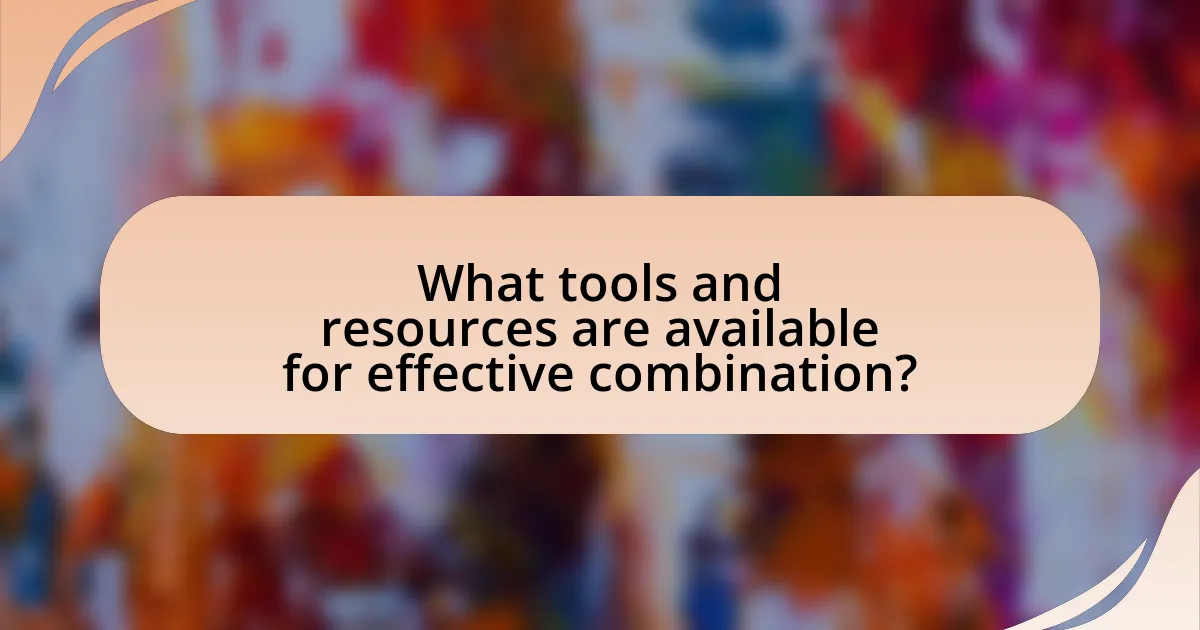
What tools and resources are available for effective combination?
For effective combination of typography and illustration, tools such as Adobe Creative Suite, specifically Adobe Illustrator and Adobe InDesign, are essential. These programs provide advanced features for integrating text and visuals seamlessly, allowing designers to manipulate typography and illustrations in a cohesive manner. Additionally, resources like Google Fonts and Adobe Fonts offer extensive libraries of typefaces that can be paired with illustrations to enhance visual storytelling. Research indicates that effective combinations of typography and illustration can significantly improve user engagement and comprehension, as demonstrated in studies on visual communication effectiveness.
What software is best for integrating typography and illustration?
Adobe Illustrator is the best software for integrating typography and illustration. It offers advanced tools for creating and manipulating vector graphics, allowing designers to seamlessly blend text and imagery. Illustrator’s features, such as the Type on a Path tool and the ability to convert text to outlines, enable precise control over typography within illustrations. Additionally, its compatibility with other Adobe Creative Cloud applications enhances workflow efficiency, making it a preferred choice among professionals in graphic design and illustration.
What features should one look for in design software?
When selecting design software, one should prioritize features such as user-friendly interface, robust typography tools, vector graphic capabilities, and compatibility with various file formats. A user-friendly interface enhances productivity by allowing designers to navigate the software efficiently. Robust typography tools enable precise control over text, which is essential for effective communication in design. Vector graphic capabilities are crucial for creating scalable illustrations without loss of quality, while compatibility with various file formats ensures that designs can be easily shared and integrated into different platforms. These features collectively support the best practices in combining typography and illustration, facilitating a seamless design process.
How can online resources aid in learning these skills?
Online resources can significantly aid in learning the skills necessary for combining typography and illustration by providing access to a wide range of tutorials, courses, and design communities. These resources often include video tutorials that demonstrate practical techniques, interactive courses that allow for hands-on practice, and forums where learners can receive feedback from experienced designers. For example, platforms like Skillshare and Coursera offer structured courses specifically focused on typography and illustration, enabling learners to grasp essential concepts and apply them in real-world projects. Additionally, websites such as Behance and Dribbble showcase professional work, serving as inspiration and reference points for learners to understand best practices in the field.
What are some examples of successful typography and illustration combinations?
Successful typography and illustration combinations include the branding of Coca-Cola, where the iconic script font harmonizes with vintage illustrations, creating a nostalgic feel. Another example is the book cover design for “The Great Gatsby” by F. Scott Fitzgerald, which often features Art Deco typography paired with elegant illustrations, enhancing the luxurious theme of the novel. Additionally, the promotional materials for the 2016 film “La La Land” effectively combine bold, modern typography with whimsical illustrations, reflecting the film’s vibrant and artistic essence. These combinations demonstrate how typography and illustration can work together to convey a cohesive message and aesthetic.
Which designers or projects exemplify best practices?
Designers such as Jessica Walsh and projects like “The New York Times” exemplify best practices in combining typography and illustration. Jessica Walsh’s work often integrates bold typography with striking illustrations, creating visually compelling narratives that enhance the overall message. The New York Times employs a seamless blend of typography and illustration in its editorial design, effectively guiding readers’ attention and enhancing storytelling through visual hierarchy and clarity. These examples demonstrate how thoughtful integration of these elements can elevate design quality and user engagement.
How can one analyze these examples for inspiration?
To analyze examples for inspiration in combining typography and illustration, one should systematically evaluate the visual elements, layout, and interaction between text and imagery. This involves observing how typography complements illustrations, noting the hierarchy of information, and assessing color schemes that enhance readability and aesthetic appeal. Research indicates that effective design can increase viewer engagement by up to 80%, as shown in studies by the Nielsen Norman Group, which emphasize the importance of visual hierarchy and clarity in design. By dissecting these components, individuals can derive innovative ideas and techniques applicable to their own projects.
What are practical tips for combining typography and illustration effectively?
To combine typography and illustration effectively, ensure that both elements complement each other in style and purpose. Use a consistent color palette that ties the typography and illustration together, creating visual harmony. Additionally, select typefaces that reflect the tone of the illustration; for example, a playful illustration pairs well with a casual font, while a serious illustration requires a more formal typeface.
Furthermore, maintain a clear hierarchy by varying font sizes and weights to guide the viewer’s eye through the design. This approach helps in emphasizing key messages while ensuring readability. Lastly, consider the placement of text within the illustration; integrating text into the illustration can create a cohesive look, while placing it strategically outside can enhance clarity.
These tips are supported by design principles that emphasize balance and unity, which are crucial for effective visual communication.
